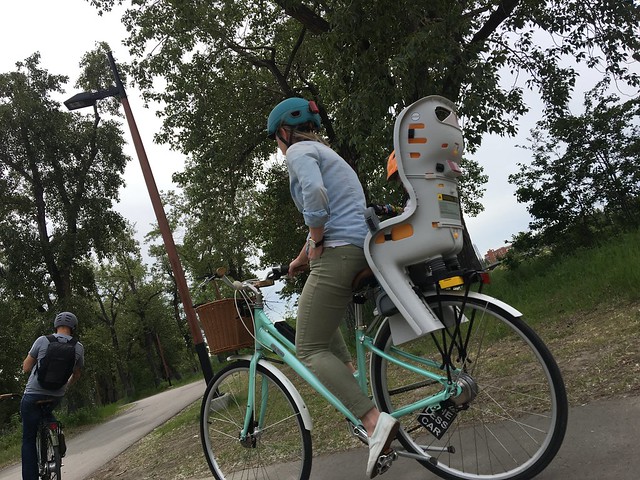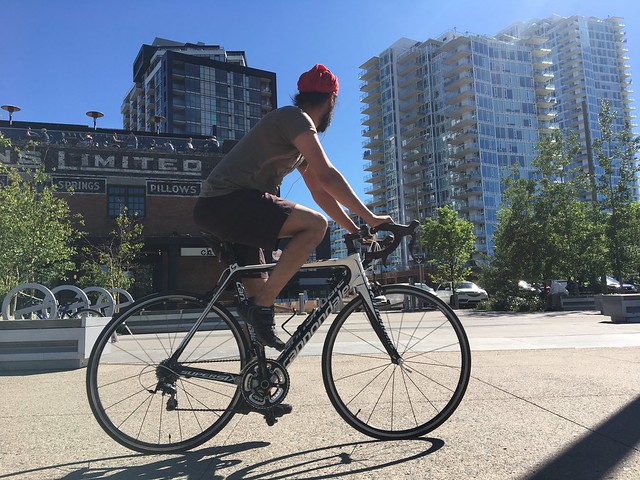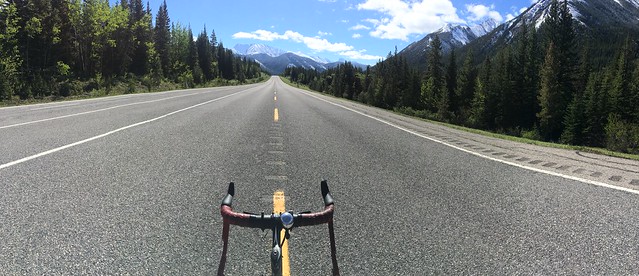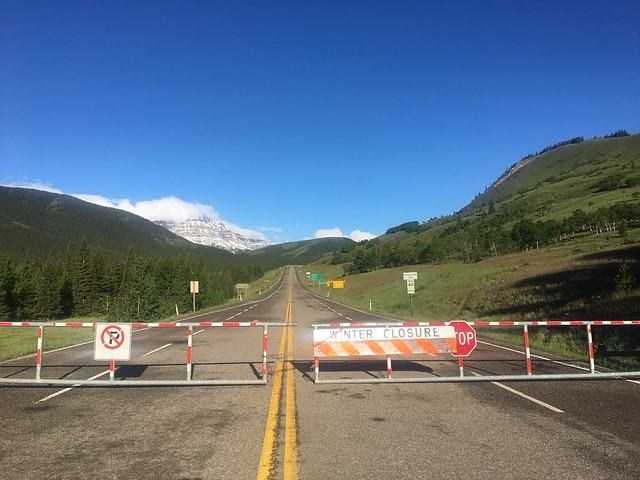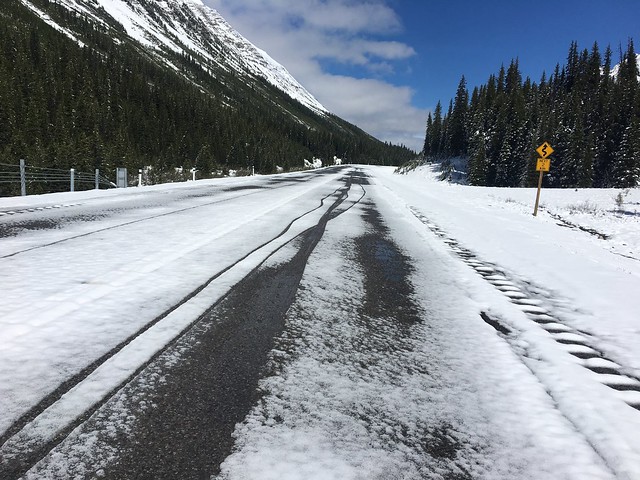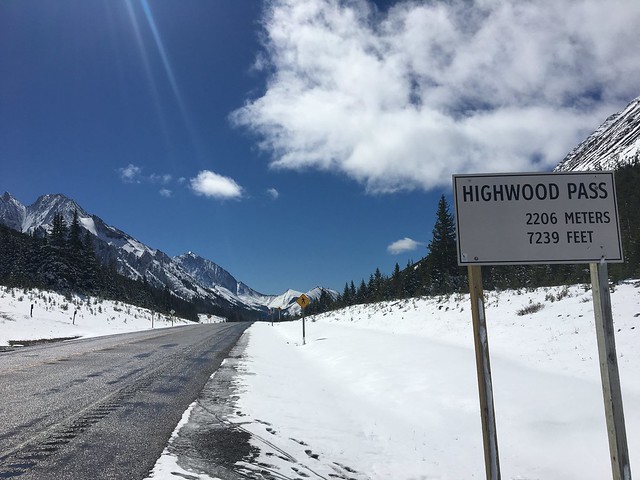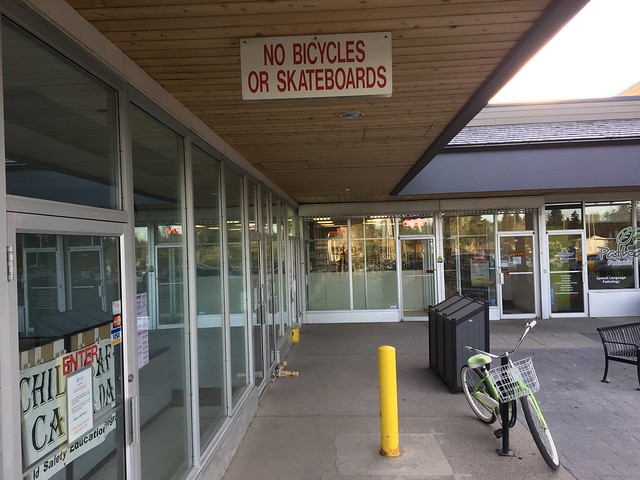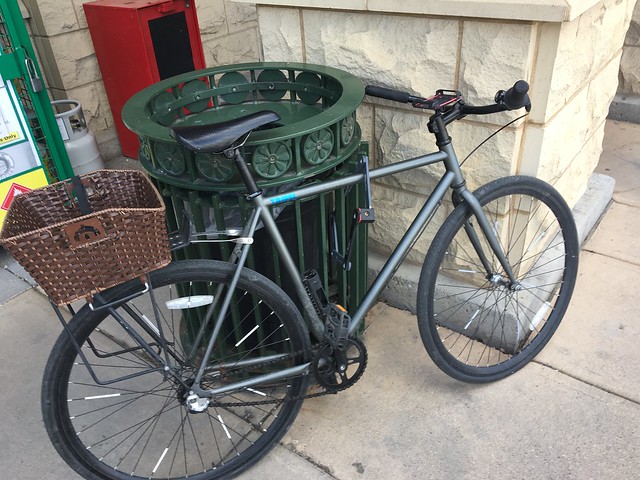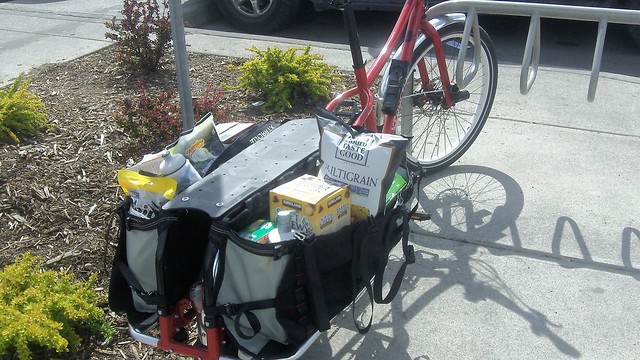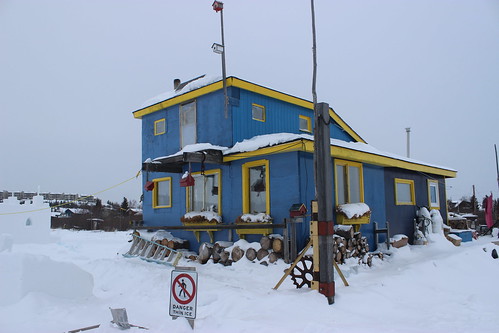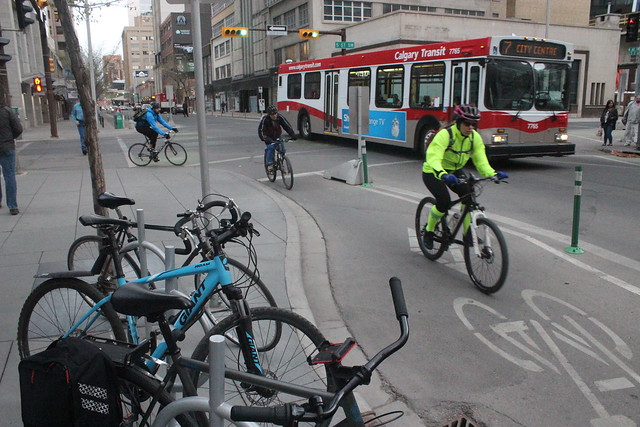My home city of Calgary made waves last year by installing an entire downtown network of separated bike lanes, all at once. Here’s a spin through the city a year later, to assess its success.
Category: Cities Page 5 of 6
In the past decade, Peter Walker has seen a fundamental change in London, the city in which he lives.
In that time, Walker, a writer for The Guardian who has for years penned the paper’s popular bike blog, says people on bikes have gone from a marginal place on the city’s streets (he says he was once viewed as a “bit of an oddball” for using his bike to get around the city) to one that’s clearly in the mainstream — during peak hours on some London roads, cyclists are now the most common road user.
Despite that, he says cycling has not moved into mainstream consciousness like it has in the world’s great cycling cities, such as Copenhagen or Amsterdam. And now, after a bike-infrastructure building boom under former mayor Boris Johnson, Walker fears the entire movement has stalled.
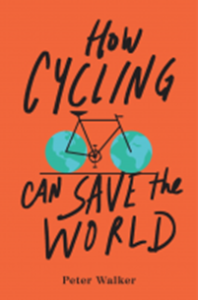
How Cycling Can Save the World, by Peter Walker
Part of that fear is what drove him to write How Cycling Can Save the World, his new title that reads like a book-length argument in favour of two-wheeled urban transportation. Covering aspects as diverse as health and safety to equality, the book lays out, in rational and precise terms, all the benefits that cycling brings to society. And they are myriad. The title of the book is not an exaggeration.
I chatted with Walker from his flat in London. Here are some of the aspects of our conversation that struck me.
Health
It’s a bit of a no-brainer, but the health benefits of cycling are sometimes forgotten in the battles with motorists over road space. In detailing some of those astonishing benefits, Walker makes a pretty good case that your doctor might be well advised to prescribe a bike commute after your next physical.
A scheme to encourage people to ride in the small Danish city of Odense, Denmark, for example, added five months to the life of the average citizen. Another study of Danes found those who rode a bike to work were 40 per cent less likely to die during the study. Other studies have found that countries with the highest rates of cycling have the lowest rates of obesity, and even that simply riding a bike leads people to more healthy diets.
“If there’s any one factor that will get cyclists riding more and more . . . it’s that developed nations are facing this public-health crisis from people living these sedentary lives,” Walker told me. “People in public health service are completely frank: if more is not done to encourage active transportation, the public health system will collapse.”
Suburban options
Much has been made over the years about the importance of distance in encouraging people to ride bikes. A five-kilometre ride to work or the supermarket is certainly more palatable to many people than what we see in most North American cities, where suburban growth patterns have stretched those distances to sometimes absurd lengths.
Walker, however, sees ways to bridge those distances. The proliferation of e-bikes in Europe and China may be a precursor to their popularization in the U.K. and North America as a way of more easily spanning longer distances. “With the Dutch, it’s something like a third of bikes sold new are e-bikes, it’s something that’s definitely going to come,” he said.
He’s also seen success with cycling “highways,” in which well-built, direct bike routes are extended out to suburbs. Cargo bikes are also making inroads as practical suburban transportation options, particularly for those hauling kids to school every day. There is also much success when transit systems are mixed with bike-sharing programs, the latter relied upon by people to cover the distance to and from the bus or train.
“The really been an explosion of Chinese bike-sharing schemes … and having these bike share systems, such that people can pick up a (bike) to a metro stop and finish their trip, are really working,” he said. “There are all these ways that the bike can work with other forms of transportation.”
Happiness
Bikes make people happier. This isn’t just your annoying bike-riding co-worker crowing about being energized after a morning ride. There’s science behind it.
Walker devotes an entire chapter to the ways in which cycling increases happiness, most of it related to the well-documented mental-health benefits of regular exercise, particularly when that exercise is simply part of getting around every day.
Most inspiringly, Walker dives into an Italian study that examined the lives of people, between the ages of 52 and 84, who rode several times a week. All were in great physical shape, seemingly years younger than their non-bike-riding peers, and seemed giddy about the mental-health benefits of such exercise. “It makes you feel good, both mentally and physically,” reported one 61-year-old in the study. “It is no small thing, to feel well with oneself.”
The stigma
It ain’t all roses. Walker doesn’t shy away from the negative bits associated with cycling, especially around the corrosive political discourse that still pervades the conversation in the U.K. and North America. Walker pushes this argument farther than I’ve seen before, detailing how the stereotyping of cyclists has serious negative consequences. While he stops short of drawing parallels between the insidiousness of racism or sexism and the way cyclists are treated, he’s clear that he thinks it comes from the same space.
“I compare to really old-fashioned things, like making jokes about vegetarians or mothers-in-law,” he says. “It just feels a bit dated.”
What’s worse, Walker quotes studies that draw links between negative portrayals of cyclists in the media and public discourse and increased danger to cyclists on the roads. It’s not a difficult mental leap to make — if drivers are pummelled with negative images of people on bikes, they are less likely to treat them with respect on the road. It’s a serious problem that needs to be overcome if cycling is to become accepted as a rational, everyday form of transportation.
The future
With so much talk about the future of urban transportation, particularly around the looming disruption of autonomous vehicles, Walker also has a rather optimistic view of the future. While’s he’s as skeptical as the next bike blogger (ahem) about the ways self-driving cars will impact the bike environment in cities, he’s looking at the bigger picture.
“Anyone who tries to predict what cities will look like in 50 years is wrong,” he said. “People are very keen to live in a place that’s seen as liveable. Even if they are electric cars, and they’re autonomous, they’ll still have an impact on the livability of cities.”
As far as the future goes, I’m keen to align with Walker’s vision of a future in which scores of people assess their lives and make a decision to ride a bike for the same reasons he does: “I live in this very congested city where getting around is quite tricky,” he said. “When I get on a bike I know I will arrive within a few minutes of when I expected, with a smile on my face.”
It was while screaming downhill, past hundreds of other cyclists who were slowly climbing in the opposite direction, that the thought crossed my mind. “Huh,” I thought. “This is a thing.”
That was on the weekend as I happily rode the Highwood Pass for the first time, a local highway that, for a few weekends a year, becomes a haven for, as I discovered, scores of fellow cyclists. But seeing so many people on this route made me realize something else: It’s rather amazing what people will do to find a good car-free route to ride their bikes.
https://www.instagram.com/p/BVXERmDAB6Z/?taken-by=tombabin
First, some background. The Highwood Pass is just another highway, but it has some special qualities. It’s called the highest paved route in Canada, and it cuts through some achingly beautiful alpine scenery in the eastern slopes of southern Alberta’s Rocky Mountains. It happens to be near where I live.
For years, I’ve heard about a special moment on the pass. The road is closed to motor-vehicle traffic during winter to offer a respite to wildlife during times of year when food is more scarce (the route passes through a provincial park). It also receives a shit-ton (for you Canadians, the metric version of that would be “shit-tonne”) of snow, so I’m sure there’s a snow-clearing budget officer somewhere who breathes a sigh of relief every autumn when the gate is lowered to close the road.
That makes for a unique situation. For a short time each spring, usually just a weekend or two, there’s a window of opportunity for cyclists between the time the gates remain closed to cars and enough snow has melted to make the road passable on a bike.
The result: Hundreds of people on bikes flock to the area for a chance to ride the pass without any cars.
It’s a wonderful experience for cyclists. Arriving early gives a rare chance to enjoy a quiet highway, with stunning mountain vistas and wildlife sightings. Arriving a little later gives an opportunity to take part in a communal bike-friendly atmosphere as all kinds of people unload their bikes at the gate and start climbing.
While the early riders tend towards the MAMILs (middle-aged men in Lyrcra, God bless them), by midday, while descending the pass, there were innumerable women, families and kids heading upwards, including at least one hearty grandmother pedalling her way up the mountain on a shiny new e-bike.
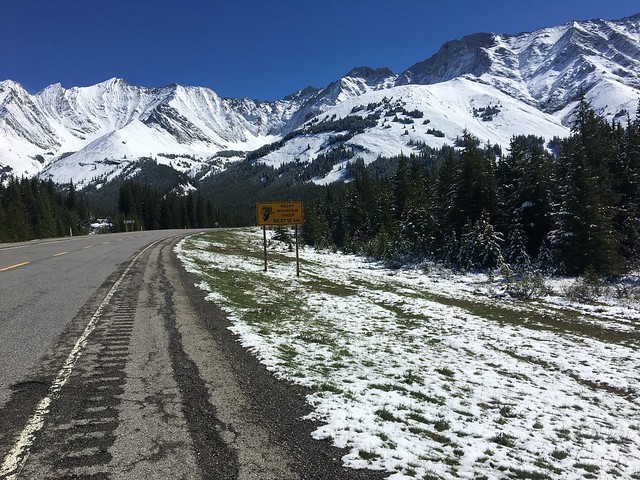
For a few weekends each spring, before the highway opens for the season, the snow melts enough to create a car-free route for cyclists.
What made it all possible was one thing: A lack of cars. If the road was open to vehicle traffic, the number of people enjoying the ride that day would dwindle to a handful of those brave and hearty souls who feel confident in their ability to stick to the shoulder of the highway while innumerable vehicles blow by at freeway speeds.
While I was delighted with the opportunity to undertake this ride, it also struck me as a little sad that such opportunities weren’t more common. I’m not naive enough to think that a highway, built with millions of taxpayer dollars, would ever be turned over exclusively to cyclists, but the fact that so many took advantage of a tiny window of opportunity to enjoy a safe ride free of cars is telling.
Many jurisdictions enable road closures for specific bike events, for everything from ciclovias to gran fondos, that draw innumerable people on bikes. It’s proof there’s a hunger out there for safe bike routes, whether they are recreational of functional. This little highway during this one weekend was just another manifestation of that desire.
For me, on a more visceral level, it took me about half the ride before I realized I could stop my subconscious habit of glancing over my shoulder to see if a car was coming up from behind, which prompted a simple thought that, I’m willing to bet, was shared with many others that day. “This,” I thought, “is pretty nice.”
Maybe it was the news that Tesla is now the largest U.S. carmaker by market cap, or maybe it has been the uncertainty around the price of oil, but there has been a flurry of futurism lately centred around looming changes to our transportation systems, specifically around autonomous electric cars.
Autonomous, electric vehicles are about to take over our lives, say prognosticators of the future, a change that has some dragging out Y2K-level hyperbole. Many of these predictions are being built on the idea of cities filled with blissfully shared roving robot-vehicles safely and orderly awaiting our smartphone hails.
Only recently, however, have those futurists started to put some thought into the impact of autonomous vehicles on our streets. A few consensuses have emerged – that driverless cars will reduce collisions, for example – but there is surprising diversity in opinion on the long-term impact on our cities.
There are plenty of Pollyanna predictions that streets will become safer, less congested places because of autonomous vehicles. But there are just as many hypothesizing that our streets are about to become a whole lot worse, particularly considering the recent troubles of the company that was once seen as the future of the city: Uber (if you missed the big New York magazine story, here’s the short version: Beyond the company being allegedly riddled with assholes, Uber has made congestion worse, not better, is still heavily subsidizing nearly every ride by as much as 60 per cent, making it barely profitable in big cities and horrifically unprofitable in small ones, thereby bringing into question the very idea that ride-sharing is the future).
No matter which side you come down on, however, one obvious thing seems to have escaped the notice of most of these predictions, even though it should be clear to anybody with a working set of eyes.
If you were to teleport to today a citizen of a decade ago into a city of today, and asked them to identify the differences in transportation, I’m willing to bet they would not mention technology, or autonomous vehicles, or smartphone apps, or even car sharing. It would be bikes.
This New Yorker said as much. The most profound change to the streets of many cities over the past decade is the prevalence of people on bikes as a practical form of transportation.
So why is this so rarely mentioned in discussions about the future of transportation? Of all the nascent transportation disruptions we’re in the midst of, question marks still litter many of them. But use of the bicycle is a proven improvement, and seems destined to keep up its breakneck growth, especially as a generation grows up with new appreciation for its practicality. Urban cycling is the most profound change to city transportation in generations, yet the allure of technology is overshadowing it.
It’s a strange omission. Yes, autonomous vehicles represent a sea change in the way we think about transportation, but swapping one type of vehicle for another doesn’t solve the fundamental problem of congestion. Nor is there any track record behind many new vanity ideas (sorry, Mr. Musk) such as boring tunnels beneath cities to facilitate even more cars. Progress is moving more people more efficiently, and there are precious few ways to do so. None of them involve adding more cars.
This isn’t a zero-sum game. There are certainly ways that autonomous vehicles can help improve the efficiency of our transportation system, but not if such thinking is done is isolation.
If you want a look at how an efficient city of the future moves people around, forget robot cars, or tunnels, or 1950’s-style car-centric road systems simply updated with new vehicles. Instead, look at Amsterdam or Copenhagen or Seville or New York or Montreal or Vancouver and the masses of people riding bikes because it’s faster, easier, healthier, more effecient, and more enjoyable than being trapped in a box, no matter how high-tech that box might be.
We live in a world of bad bike racks. Poorly designed or haphazardly placed, bad bike racks do more than bring a tear to the soul of urban riders: They are a thief’s best friend, a repair shop’s dream, and are a blatant reminder to cyclists that society doesn’t care enough about them to simply provide a decent place to park.
It doesn’t have to be this way. A simple, functional, secure bike rack may be the easiest construct of our cities. Yet here, thanks to Shifter readers sharing their bike-rack horror stories, are the many ways we’ve screwed it up. Read it and weep (until the end, where some positive signs emerge).
(And this page may load slowly, thanks to all the awesome photos shared by readers. Please be patient).
Bad design
The classic wheel-manglers: These offer the illusion of offering ample spaces for bikes, but they excel only at mangling front wheels. Also, because many bikes don’t even fit into those little slots, usually the first person to use the rack plants their bike sideways and takes up three-quarters of the rack. Sorry, second-comers, you’ll have to use that lamppost over yonder.
[facebook url=”https://www.facebook.com/photo.php?fbid=10213298211712787&set=p.10213298211712787&type=3&theater”]
[facebook url=”https://www.facebook.com/photo.php?fbid=10158677464270287&set=p.10158677464270287&type=3&theater”]
In fact, @itsakev offered an entire gallery of ways in which this type of rack sucks hard. Here are a few choice samples
[tweet 860576380521553920 hide_thread=’true’]
[tweet 860575639199293440 hide_thread=’true’]
[tweet 860576915077255168 hide_thread=’true’]
The modern wheel-mangler: A new twist on the classic wheel-destroyer, this one gets points for the efficiency of pre-fab concrete, but big deductions for being designed by someone who has never realized the importance of an unbent wheel.
[tweet 865449413010890753 hide_thread=’true’]
Too fat for locks: These have a nice steam-punk meets-Bauhaus look about them, but if the business side of the bike rack is nearly too wide to accommodate a U-lock, it’s a problem.
[facebook url=”https://www.facebook.com/photo.php?fbid=10158672904795287&set=p.10158672904795287&type=3&theater”]
DIY disaster: I’m all for DIY, but usable racks are used for both parking and security. With nothing to lock to, this one fails at the second.
[facebook url=”https://www.facebook.com/photo.php?fbid=10155127807575196&set=p.10155127807575196&type=3&theater”]
Half-and-half: These popular swirling racks, which you could call the endless W (but probably shouldn’t), are only half terrible. That’s the half where the little loop is too small to accommodate a wider wheel. The other half, where the loop opens up to any bike and even keeps them upright, is A-OK.
[facebook url=”https://www.facebook.com/photo.php?fbid=10158672909505287&set=p.10158672909505287&type=3&theater”]
Older and worser: Sometimes, a bad rack ages and gets worse. Think of it like the opposite of fine wine. More like aged milk, perhaps.
[tweet 865352153468026881 hide_thread=’true’]
Bad placement
The second part of terrible bike racks is poor placement. Sometimes a good rack put in a bad spot is worse than no rack at all.
Lonely racks: I suspect whomever paid for and placed this rack is quite pleased with themselves for accommodating cyclists, yet the placement of this wheel-mangler somehow elicits strange feelings of sadness and loneliness.
[facebook url=”https://www.facebook.com/photo.php?fbid=10213298203672586&set=p.10213298203672586&type=3&theater”]
Proximity problem: We’ve already established that this style of rack is actually half-good, but when placed so close to a wall the bike doesn’t fit properly through it, the rack devolves to mostly terrible.
[tweet 862249608084205568 hide_thread=’true’]
Onwards and upwards: These racks are pretty good, but not when placed on a step where the poor cyclist needs to heave the bike upwards and hope it doesn’t roll down while the lock is being afixed.
https://www.instagram.com/p/BUVw2ctAmZP/
Wallflowers: More good racks placed too close to a wall to make them fully usable, this one with the added indignity of being located in the middle of a bank ATM drive-through.
[tweet 865448732073918464 hide_thread=’true’]
Bike-rack afterthoughts: It’s nice for businesses to think about their customers who arrive by bicycle, but finding a little hovel far from the front door, up a few steps, and too close to a wall to be usable is just plain annoying. As one commenter on this thread said: “There seems to be plenty of parking spots for vehicles but lacking in spots for bikes or trikes! . . . I’m getting sick of locking up to a tree or street sign post.”
[facebook url=”https://www.facebook.com/tom.babin/posts/10158633682500570″]
Mixed messages: A good rack, placed beneath a sign that isn’t so much.
Nonexistent: If you ever see bikes locked to trees, parking meters, lampposts or, in this case, railings, it’s the ultimate bike-rack fail: not installing a rack at all.
[tweet 865450595116752896 hide_thread=’true’]
The good ones
Lest anyone read this post and think that cyclists are a bunch of entitled crybabies who feel they are owed such things as reasonable parking spots, let’s give a shout-out to all those business owners and municipal planners who are doing bike-parking right. Kudos to you, thoughtful people: may the cyclists of the world shower upon you their hard-earned spending money and civic voting patterns.
[facebook url=”https://www.facebook.com/felipe.g.morales.16/videos/p.10154543312327197/10154543312327197/?type=2&theater”]
Making space: This parking garage proves that removing just a few spaces for cars and installing a decent bike rack can be a boon for dozens of cyclists.
[facebook url=”https://www.facebook.com/photo.php?fbid=10158674108380287&set=p.10158674108380287&type=3&theater”]
Simplicity works: See, this doesn’t have to be complicated! These simple racks can accommodate bikes on both sides, can fit many bikes into a small location, and are perfectly functional.
[facebook url=”https://www.facebook.com/photo.php?fbid=10211297708971044&set=p.10211297708971044&type=3&theater”]
Beauty and functionality: Many cities have taken bike racks beyond function and are looking at them as pieces of public art. One of the first was musician David Byrne’s artistic racks in New York City, but many cities are following suit, and improving. Here are a few examples.
[tweet 774271702775631872 hide_thread=’true’]
[tweet 865415794963783681 hide_thread=’true’]
Thanks to everyone for sharing these photos. The purpose of this post is not to shame the guilty paraties. Bad bike racks can happen to good people. But if your business hasn’t put much thought into accommodating your customers on bike, perhaps it’s time to do so.
If you have a particularly great, or discouragingly terrible, rack, drop me a line on Twitter, Facebook, Instagram or via email.
“Big grocery.”
That is a slightly tongue-in-cheek suggestion about how to make cities more bike friendly by Ontarian Lana Stewart, who speaks and writes thoughtfully about the fixation of urban cycling advocates on commuters, despite statistics showing that a huge percentage of car trips are elsewhere, such as running errands, shuffling kids to activities and, yes, getting groceries.
In the shadow of “big commute,” she suggests more attention be given to “big grocery.”
Stewart’s is a rather colourful way of drawing attention to the fact that suburbs often get overlooked in discussions about urban cycling. This has deeper ramifications than just inconvenience. In the changing nature of cities, suburbanites are often home to people who can’t afford inner-city living, which means those who could most benefit from improvements to cycling (one of the more affordable transportation modes available), are often left out of the conversation.
 Darnel Harris, another Ontario advocate, takes the argument even farther, saying those who live in the suburbs can be marginalized by bike infrastructure in a couple of ways. Conversations about urban cycling often denigrate the ‘burbs, making people feel shame in their communities. And bike lanes often are precursors (or symptoms of) gentrification, which can push low-income residents out of their own neighbourhoods. There have even been protestations against bike lanes in some communities, based not on the usual anti-bike ignorance, but from those afraid that bike lanes will drive out the poor.
Darnel Harris, another Ontario advocate, takes the argument even farther, saying those who live in the suburbs can be marginalized by bike infrastructure in a couple of ways. Conversations about urban cycling often denigrate the ‘burbs, making people feel shame in their communities. And bike lanes often are precursors (or symptoms of) gentrification, which can push low-income residents out of their own neighbourhoods. There have even been protestations against bike lanes in some communities, based not on the usual anti-bike ignorance, but from those afraid that bike lanes will drive out the poor.
This is a horrific situation considering affordability should be one of the key benefits of using a bike. In fact, one of the great success stories of urban cycling is the way bike lanes help better integrate poor residents into cities. Urban cycling hero Enrique Penalosa, former mayor of Bogota, Colombia, once said that bike lanes show that “a citizen on a $30 bicycle is equally important to one in a $30,000 car.”
There’s no easy to solution to all of this. Retrofitting suburbs to be more friendly to active transportation in a way that doesn’t lead to gentrification would be the ultimate answer, but it’s expensive, slow and difficult. But there are some other good ideas circulating. Harris, for one, is pushing a project to bring cargo bikes to the ‘burbs, based on the idea that people will be better able to capitalize on their utilitarian nature without having to wait for expensive infrastructure improvements that could change their neighbourhood.
It’s an intriguing idea, and at least gets the conversation started on ways of becoming more inclusive while those long-term retrofits finally make their way outside of expensive urban areas.
“Postholing” is a new cycling verb I learned this week, defined to me as I lay prone in three feet of light powder at -26 C in the sub-Arctic taiga of northern Canada.
For the record, the word describes what happens when your foot sinks deep into snow, as any showshoer (sans snowshoe) knows. When it comes to fatbiking, however, it tends to occur along a packed trail when you slow to a stop and place a foot down into the adjacent powder that looks only a few centimeters deep, but is, in actuality, up to your crotch. Your foot sinks deep into what now looks like a hole dug for a fence post, and the rest of your body follows, sprawling into the powder. Laughter, usually, ensues.
That was only one of the things I learned on a recent trip to Yellowknife, the capital of Canada’s Northwest Territories, a city of 20,000 that hugs the shores of the massive, frozen (at least it was when I was there) Great Slave Lake. I was invited by David Stephens or Boralis Bike Tours Unlimited (go book a guided fat-bike trip with him right now, especially if you want to take the last-ever trip down the ice road to Arctic coast) to speak about winter cycling, but it’s entirely possible I learned more from Yellowknifers than I could ever hope to teach them.
Yellowknife is an idiosyncratic, oft-overlooked, and completely charming, aberration. Outsiders may think this place shouldn’t exist, with its harsh weather, unforgiving environment, and isolation, but that shows what outsiders know. Yellowknife is a vibrant, diverse, endlessly surprising place. Lured by the promise of adventure, people from all over the world make their homes here, giving life to heritage shacks built into ancient bedrock and houseboats socked in by ice for half the year.
And even in mid-March, when a temperature of -15 C was greeted as a heat wave, there are people everywhere outdoors enjoying the season, even on bicycles.
Yes, even here, perhaps the least likely place in the world to think about riding a bike, people have found that two wheels can be a key to a better life. In fact, Yellowknife has some qualities that make it a great place for bikes. Here’s a list I’ve been keeping:
- The city is small, meaning distances are short and easy to ride. As Stephens told me before I arrived: It’s possible to ride your bike to your destination in the same time it takes to simply warm up your car. Speed limits are slow, and car traffic is light.
- The snow is uniquely favourable to bikes. With the cold temperatures, there’s little of the freeze-melt ice cycle that bedevils other cities. The snow that gets packed offers good traction in most places.
- It’s too cold here for salt to be effective as an ice-melter, so it’s rarely used. That means you’re not risking rust every time you take your bike into the streets. It also helps keep the city nice and white for most of the winter, rather than the snirty brown of other places.
- This place is awesome for fatbiking. Stephens guided me through some glorious trails that spread in and around the city. Ample snowfall in evergreen forests is quickly packed down by snowmobiles, which creates ideal tracks for fatbikes that are ringed with delightful powder (as evidenced by the aforementioned post-holing).
- Once the lake freezes, roads are plowed on the ice, which create nice shortcuts for bikes, especially after a stabilizing layer of packed snow lays down (and imagine riding a fat bike beneath the northern lights on an ice highway. Go ahead, imagine it.)
But what I found most inspiring here was the way Yellowknifers deal with winter. Unlike farther south, I rarely heard people complain about the winter. Some have simply accepted it as a reality of life in the north, but most people I encountered told me they actually enjoy it. They were quick to offer tips about staying warm, they showed off clothing and tricks that I had never encountered before, and the city is full of fun events to get people enjoying winter.
Stephens even organized my speaking engagement in the great hall of the Snowking’s snow castle, an amazing structure built of packed snow (don’t you dare call it an “ice” castle) that is the locus of a month-long winter festival. So, in other words, I delivered my speech in a snow castle on a frozen lake, which I feel confident saying would not happen anywhere else.
This is the kind of attitude that primes a community to year-round cycling. There’s a core group of people in town who have already seen the benefits, but I’m willing to bet a little nudge would encourage a whole raft of other people to give it a try. Some safe bike infrastructure, a commitment to maintaining bike routes all year, some reliable bike parking locations and even some support of the local fatbiking community would go a long way.
After all, people who have verb to describe a specific way of falling into the snow are probably well on their way to a more bike-friendly life already.
Back in 2013, after seeing the Finnish city of Oulu for the first time, I wrote a post called Never Mind the Plows. The idea was to focus on things that can improve winter cycling beyond the basics. Any by basics, I meant plowing.
Well, five years later, as much of the winter world has seen the benefits of encouraging people to ride in winter, like they do in Oulu, it’s even more clear now that perhaps nothing is as important to the adoption of winter cycling than plain, boring, overlooked, unsexy, plows. (Or brushes. Or shovels. Or whatever gets rid of the snow efficiently).
In Calgary, where I live, the snow clearing of downtown bicycle lanes has been (much to the consternation of professional complainers) pretty great over the last few years. With an ever-expanding network of bike paths being cleared, the city’s efforts in winter have resulted in a growth in the number of people riding in winter that has kept pace with the growth of those riding in summer.
At the city’s Peace Bridge, one of the busiest bike spots in the city, for example, the growth in cyclists from 2014 to 2016 in the summer was about 27.2%, according to publicly available bike counts. In winter over the same period, that growth was 25.4%. The number of people riding in winter is obviously smaller (about 35% of summer numbers), but fact that that growth is consistent across seasons is some evidence, I’d argue, that clearing bike lanes works. It means there is growth potential in winter.
Just ask Montreal. This city, the most bike-friendly on the continent, in my humble opinion, has, for years, taken literally that old headline of mine. Rather than bike lanes free of snow, many of those routes were actually closed for winter. The traffic poles that separated bike lanes from car lanes were removed, and the space was given back to cars. For people who rely on bikes for transportation, this was a gigantic, demoralizing sigh, and it was reflected in a smaller proportion of people riding year-round.
But even in Montreal, where snow removal may be an even bigger political headache than it is elsewhere (and, make no mistake, it is everywhere), that idea is finally being rethought. More and more bike routes are being kept opened in winter, and the city has officially committed to making all bike routes accessible in winter eventually. City officials have even agreed to look at ways of keeping a crucial bike route across the St. Lawrence River open year-round, including exploring the possibility of in-ground heating to keep the route ice-free.
Talking about it, however, is the easy part. Doing it is hard. During a recent trip to Montreal, the city was digging out from a series of snowfalls compounded by an ice storm that left many streets and sidewalks slick as a skating pond. As news spread that city officials were vowing to keep more routes open in winter, cyclists took to Twitter to, ahem, politely advise them to figure out how to keep their current commitments before adding new ones. Indeed, news about opening the bridge in winter only came after years of pleas from cyclists and a protest campaign.
Those tweeters aren’t wrong. This city, so lovely to pedal through in summer, has some work ahead of it before it becomes just as good in the winter. It will be interesting to watch in the coming years how this new approach impacts the number of people riding.
But let’s face it: Keeping bike routes free of snow is tough. It takes commitment, ingenuity and, most importantly, money. It will never be easy, and it may always be a political hot button (hell, even after 80 years of plowing roads for cars, it’s still a hot button). But the upside is worth the investment and risk. Just ask the growing number of people who ride year round.
Montreal, perhaps North America’s most bike-friendly big city, is finally looking at ways of making it easier for people to ride a bike through the winter. Here’s what we learned on a recent trip.
Monday was a big day for Calgary. After an 18-month pilot project testing out a downtown network of separated bike lanes, city council voted to make the project permanent. It was a squeaker of a majority vote that approved the pilot project in the first place, so its permanence was never assured.
In the end, more city councillors voted in favour of keeping the network than approved the pilot project in the first place, which means several changed their votes in favour after seeing the bike lanes in action. “I was a person that didn’t support this in the beginning. I thought this was madness,” Coun. Diane Colley-Urquhart told reporters after the vote. “But, to see how it’s evolved, and how it’s working and to see how people are starting to get the fact that this is shared public space.”
I argued in favour cycle tracks in places like this, this and this, so I’m certainly pleased with the result in my home town. The process also taught us much that may be applied to other cities.
Boldness paid off
In a city known for suburban sprawl, a love of the automobile, and public works timidity (the city is still debating whether extra money should be spent to bury a commuter train line, even though its at-grade predecessor is regularly plagued by bad weather, tangled traffic, errant motorists who crash into it and, all-too often, pedestrians getting run over) installing an entire network of separated bike lanes all at once was a bold step. It could have easily backfired — opponents cited the costs, the disruption on downtown traffic, and the displacement of parking spaces, among other things, as reasons to hate the idea.
In the end, it seems that installing the entire network all at once worked because it offered up the big picture. It might have been easier politically to build the network one lane at a time, as most cities do, but the uptake on a lane with few connections would have been slow. In this case, dropping down a well-thought out network gave cyclists and would-be cyclists a broader peek at what a cycle-track network can do, and, more importantly, have them somewhere to go.
The network didn’t succeed because of its boldness. It succeeded because it was practical. But in the politically charged climate around cycling, boldness was needed to ensure it was functional.
Tweaking
It wasn’t smooth sailing for the entire network, and perhaps it never will be. One things that seemed to placate opponents on city council was assurances that the network will continue to be tweaked to fix problems that arise.
Such tweaking was one of the city’s best practices since the bike lanes were installed. During the 18 months of the pilot, city planners reconfigured conflict zones, rejigged transition points, and adjusted intersections. This was crucial to the network’s success, and to public support. If people feel that problems will be fixed, it tends to dial down the opposition.
Part of Monday’s decision was a re-investment in the network to focus on areas that still aren’t perfect. And, let’s face it, there are many of them. In fact, one of the more troubling aspects of the pilot project was the fact that the number of bike collisions on these routes actually increased, which was contrary to the experience of separated bike lanes pretty much everywhere else. It turns out that most of those collisions were minor, occurred early in the pilot project, and were mitigated (mostly) with some design tweaks.
That’s why tweaking is important. Let’s hope that attitude of constant improvement carries into the future.
Data
The debate, both before and after the pilot project was installed, focused largely on numbers. Were there enough cyclists in the city to justify the expenditure? It’s a fair question, but before the installation, it was a chicken-and-egg scenario: how were we to know how many people would ride a bike before they were given a chance to ride?
As a result of that debate, the network became almost certainly the most scrutinized 6.5 km stretch of asphalt in the city’s history. There were more than 80 measures that were taken to judge the pilot project’s success, part of which was the installation of an array of automatic counters that post daily results to a public website.
This data was key to the debate throughout the project, probably because there was such uncertainty about it to begin with. Having solid, reliable data is key when such uncertainty exists.
Beware the data
Data is great, sure, but if the debate around Calgary’s bike-lane network proved anything, it’s that even data can be politicized.
Despite the 82 measures that were taken to gauge the success of the project, critics still found ways to poke holes in it. They said the wrong measures were taken, the data was manipulated, and the numbers were unreliable. For as much as good data is key, there’s also a risk of being over-reliant on numbers.
Safe cycling, or at least the perception of safe cycling, isn’t a completely data-driven exercise. Example: Cycling is, according to some studies, just as safe as walking or driving a car, but the perception among many would-be cyclists is that it’s dangerous. Part of what makes separated bike lanes work is that they are safe, sure, but also that they build the perception of safety. I’ve often said that riding in a safe bike lane is something you feel in your gut more than your head. They just feel better to ride on.
It’s difficult to quantify these social or psychological aspects in numbers, and they risk being lost if the emphasis is too much on cold, hard data.
We ain’t done
Calgary’s cycling community spent much of the evening after the city council decision backslapping, and there is nothing wrong with celebrating. But let’s also avoid getting smug about this political victory. This is the first step in making Calgary a truly bike-friendly city, and much work remains. Despite the success of the pilot project, and the increases in the number of people riding, those numbers remain small. If this pilot project proved anything, it’s that there’s only slightly more than potential in Calgary right now. To turn that potential into people on bikes will take work: improving connections, solidifying the network, educating everyone in the city and improving safety. Let’s get on with it.


